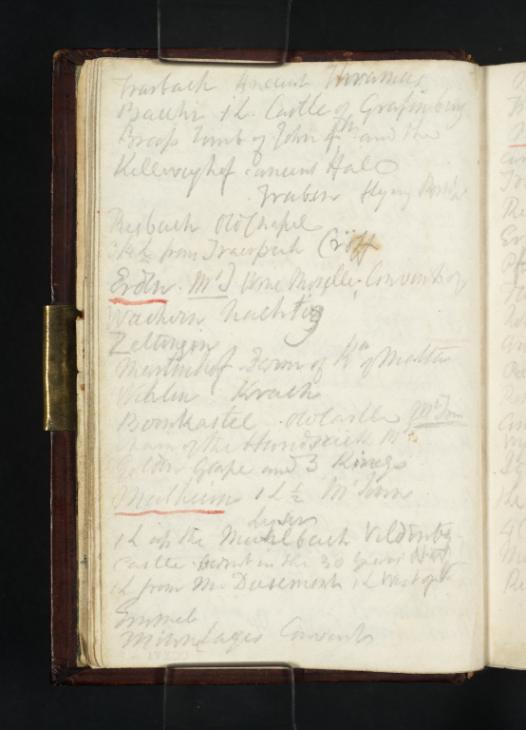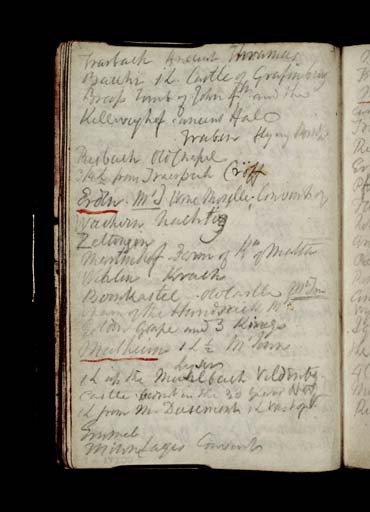Joseph Mallord William Turner Notes of Sights between Koblenz and Trier 1824
Image 1 of 2
Joseph Mallord William Turner,
Notes of Sights between Koblenz and Trier
1824
Joseph Mallord William Turner 1775–1851
Folio 7 Verso:
Notes of Sights between Koblenz and Trier 1824
D19565
Turner Bequest CCXVI 7 a
Turner Bequest CCXVI 7 a
Pencil and pen and red ink on white wove paper, 118 x 78 mm
Inscribed in pencil and pen and red ink by Turner (see main catalogue entry)
Inscribed in pencil and pen and red ink by Turner (see main catalogue entry)
Accepted by the nation as part of the Turner Bequest 1856
References
1909
A.J. Finberg, A Complete Inventory of the Drawings of the Turner Bequest, London 1909, vol.II, p.668.
1978
Agnes von der Borch, Studien zu Joseph Mallord William Turners Rheinreisen (1817–1844) (Ph.D. thesis, Rheinischen Friedrich-Wilhelms-Universität, Bonn 1972), Bonn 1978, pp.61–2.
1980
Agnes von der Borch and Gerhard Bott, J.M. William Turner: Köln und der Rhein: Aquarelle Zeichnungen Skizzenbücher Stiche, exhibition catalogue, Wallraf-Richartz-Museum, Cologne 1980, p.86.
1991
Cecilia Powell, Turner’s Rivers of Europe: The Rhine, Meuse and Mosel, exhibition catalogue, Tate Gallery, London 1991, pp.37 fig.25 and note 1 [p.60], 122 no.36.
1995
Cecilia Powell, Turner in Germany, exhibition catalogue, Tate Gallery, London 1995, p.30 note 4 [p.77].
This is the third of four pages of notes Turner took from the ‘Third Excursion’ section of Alois Wilhelm Schreiber’s The Traveller’s Guide down the Rhine (see also Tate D19563–D19564, D19566; Turner Bequest CCXVI 6a–7, 8). The manuscript notes on these pages list the names of towns and the distances between them, sites of historical interest, antiquities, picture collections, inns and travel information for the journey between ‘Coblentz to Trêves’ when travelling ‘the course of the Moselle’.1 Turner’s use of Schreiber’s guidebook, published in English in 1818, is discussed in the general Introduction to this tour.
The artist’s notes are transcribed thus:
‘Trarbach Ancient Thronus
Bacchi I L Castle of Grafinburg
Brass Tomb of John 4th and the
Kellereyhof ancient Hall
Traben flying Bridge
Risbach Old Chapel
¾ L from Traerbach Cröff
Erden Mt T wine Moselle Convent of
Wachern Nachtig
Zeltingen
Martinhof Farm of Kn of Malta
Wehlen Krach
Bernkastel Old Castle Mt Town
Chain of the Hunsdruck Mts
Golden Grape and 3 Kings
Mulheim 1 L ½ Mt Town
Lyser
1 L up the Muhlbach Veldentz
Castle burnt in the 30 years War
1 L from M Dusemont 1 L West of V
Emmel
Minnlages Convent.’
Bacchi I L Castle of Grafinburg
Brass Tomb of John 4th and the
Kellereyhof ancient Hall
Traben flying Bridge
Risbach Old Chapel
¾ L from Traerbach Cröff
Erden Mt T wine Moselle Convent of
Wachern Nachtig
Zeltingen
Martinhof Farm of Kn of Malta
Wehlen Krach
Bernkastel Old Castle Mt Town
Chain of the Hunsdruck Mts
Golden Grape and 3 Kings
Mulheim 1 L ½ Mt Town
Lyser
1 L up the Muhlbach Veldentz
Castle burnt in the 30 years War
1 L from M Dusemont 1 L West of V
Emmel
Minnlages Convent.’
The road from the Stephansberg leads the traveller to Trarbach, the ‘ancient capital of the county of Sponheim’ and a place ‘remarkable for its history and situation’, according to Schreiber.2 ‘It is said to have been the place called Thronus Bacchi, in the time of the Romans; and traces of the Roman road from Trêves to the Rhine are still visible’.3 At Trarbach, too, is the castle of Gräfinbourg, built by the formidable ‘Lauretta of Solms, a woman of great courage’ who kidnapped and held to ranson the belligerent Archbishop Baldwin, persecutor of the local vassals.4 With the sixty thousand gold florins she gained from his ransom, Lauretta, the wife of Henry II of Sponheim, was able to construct her Gräfinbourg and the town of Trarbach close by, making both ‘very strong’.5 Trarbach itself is described by Schreiber as ‘extremely beautiful, as well as healthy’, and ‘surrounded by mountains, hills covered with vines, and fertile valleys’.6 Its trade ‘consists principally in wine, meat, madder, leather, wool’ and ‘lime’.7 The church there ‘is the most conspicuous object in the town’, and contains ‘the brass tomb of John IV, the last Count of Sponheim, who died in 1437’.8 This, along with the ‘Kellereyhof, an ancient convent of templars’ deserves the notice of a traveller ‘on account of its large hall’.9 On the opposite bank to Trarbach is the ‘old market-town of Traben’, the two connected by a flying bridge.10 Above it, is the ‘small village of Risbach, with an old chapel’ and ‘three quarters of a league’ away is Cröff.11
From this point, Schreiber writes that ‘both sides of the river now appear covered with villages, market-towns and convents’.12 The first of these is Erden, ‘situated at the entrance of the ancient county of Sponheim, where one of the best wines of the Moselle is produced’.13 The convent of Wachern and Nachtig and ‘opulent’ market town of Zeltingen greet the traveller next, and then, ‘at some distance’ away, the ‘farm of Martinshof, which was formerly the property of the Knights of Malta’.14 Following the Moselle, the villages of Wehlen and Krach present themselves, before the river bends into a wide loop and the traveller reaches Bernkastel. ‘Situated at the extremity of the chain of mountains forming the Hundsrück’, the town is home to an ancient castle, thought to have been built on Roman foundations.15 It was ‘enlarged’ and ‘strengthened’ in the medieval period and later transformed into ‘a delightful summer residence’, only to be destroyed by a fire in 1692 when a ‘great number of pictures, and other valuable articles’ were lost.16 Should the traveller choose to rest his weary body at Bernkastel, or to imbibe the offerings of the celebrated local wineries, Schreiber recommends the Golden Grape or the Inn of the Three Kings.17
‘A Leage and a half’ from Bernkastel is the market town of Mühlheim, ‘where the rivulet Muhlbach joins the Moselle’, and the village of Lyser which is situated on the opposite bank.18 Following the Muhlbach inland the traveller reaches Veldenz, where a castle constructed by the counts of that name can be found. Burnt down in the Thirty Years War (1618–48), only the remains of it still stand.19 One league west of Veldenz, following the course of the Moselle, the village of Dusemont comes into view, and later Emmel and Minnheim where the convent of Eberhardklause stands ‘at the foot of some mountains’.20
Alice Rylance-Watson
February 2014
How to cite
Alice Rylance-Watson, ‘Notes of Sights between Koblenz and Trier 1824 by Joseph Mallord William Turner’, catalogue entry, February 2014, in David Blayney Brown (ed.), J.M.W. Turner: Sketchbooks, Drawings and Watercolours, Tate Research Publication, April 2015, https://www


